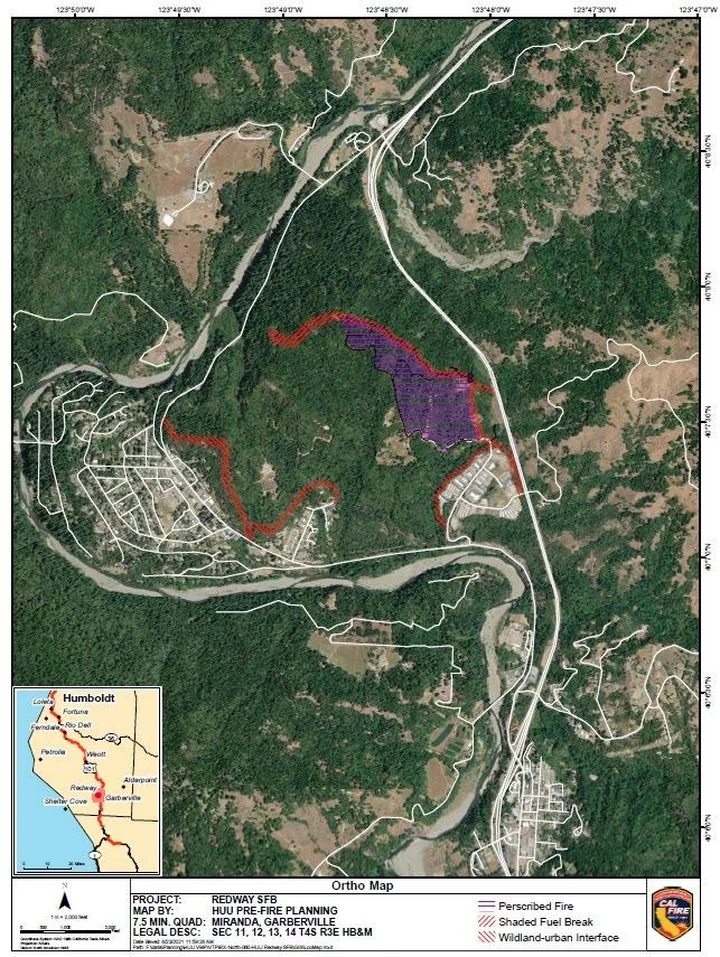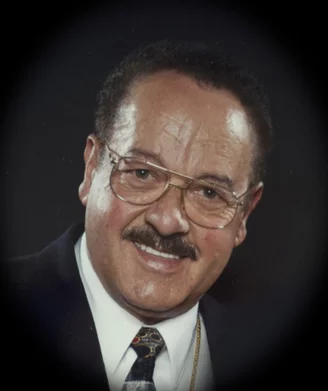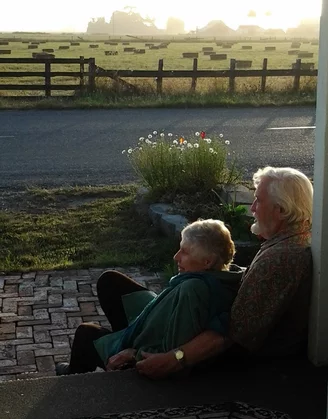Big Prescribed Burn Planned for the Redway Area This Week, and It’ll Likely Affect Highway Traffic
LoCO Staff / Monday, Oct. 6 @ 8:30 a.m. / Non-Emergencies
Press release from Calfire:
Prescribed Burn Redway Shaded Fuel Break RX
What: The final phase of the Redway Shaded Fuel Break (SFB) Project involves the implementation of a prescribed burn across approximately 84 acres.
When: The prescribed burn is planned between Wednesday, October 8th – 11th, 2025, weather dependent.
Where: Project area is located adjacent to the community of Redway, CA between Evergreen Road and Highway 101.
Why:
The Redway SFB Project encompasses 142 acres of land adjacent to the community of Redway. Fuel reduction work was conducted by contract crews utilizing a variety of methods, including mastication, hand tools, weed eaters, chainsaws, and wood chippers. Treatments included brush removal, understory thinning, and the felling of small, suppressed, and overcrowded trees. Remaining trees were pruned of lower limbs to remove “ladder fuels,” which are vegetative materials that allow wildfire to climb from surface fuels such as grass and brush into the tree canopy.
All removed material was either lopped and scattered or chipped into mulch to reduce fuel continuity. These treatments serve to break up dense vegetation, reduce fire hazard severity, and promote healthier forest conditions within the wildland-urban interface.
The final phase of the project is an 84-acre prescribed burn located in the northeast portion of the treatment area. This carefully planned burn will further reduce residual fuels, enhance the effectiveness of the shaded fuel break, and strengthen wildfire resilience for the surrounding community.
Who:
Redway SFB reduction project is a collaborative effort between CAL FIRE Humboldt – Del Norte Unit, Southern Humboldt Fire Safe Council, and the Humboldt County Resource Conservation District. This project is a result of the ongoing efforts of the Southern Humboldt Fire Safe Council to improve the resilience of Southern Humboldt communities to wildfire.During these prescribed fire operations, residents may see an increase in fire suppression resource traffic, smoke will be visible and traffic control may be in place. Please be cautious for your safety as well as those working on prescribed burns.
Learn more how you can prepare for wildfire by visiting: www.ReadyForWildfire.org.
For more information, please contact the CAL FIRE Humboldt – Del Norte Unit Public Information Officer line at: (707) 726-1285.
BOOKED
Today: 6 felonies, 10 misdemeanors, 0 infractions
JUDGED
Humboldt County Superior Court Calendar: Today
CHP REPORTS
SR200 E OFR / US101 S (HM office): Trfc Collision-1141 Enrt
ELSEWHERE
RHBB: Fatal Fire in Phillipsville Encampment Under Investigation
Governor’s Office: Governor Newsom cuts red tape to help communities clean up and rebuild faster following the TCU Lightning Complex fires
Governor’s Office: Governor’s actions and local efforts push permit approvals for LA fire recovery forward at rapid pace
RHBB: Midday Crash at F and Buhne Sends Car Into Yard but No Injuries Reported
California Braces for ‘Devastating’ Expected Cuts to Federal Homeless Housing Funds
Marisa Kendall / Monday, Oct. 6 @ 7:33 a.m. / Sacramento
A person walks past a homeless encampment along X Street under State Route 99 in Sacramento on Oct. 25, 2024. Photo by Fred Greaves for CalMatters
###
This story was originally published by CalMatters. Sign up for their newsletters.
###
The latest blow in a seemingly endless barrage of bad news for the California agencies tasked with fighting homelessness looms: President Donald Trump’s administration is expected to deeply cut federal funding for permanent housing.
The news has sent counties throughout California into a panic. The state is bracing to lose hundreds of millions of dollars for permanent housing, which is the one thing experts agree on as the most effective way to solve homelessness.
Across the state, homeless service providers and local leaders are convening emergency meetings to figure out just how bad the cuts are going to be and what to do about them. Some are scrambling to move money around or even re-label their programs to save hard-won housing. Others have already started helping fewer people in anticipation of the cuts.
But they agree on one thing: If these cuts go through, thousands of California’s most vulnerable residents likely will be evicted from their subsidized housing, and may end up back on the street.
It would likely reverse recent progress made in fixing the state’s severe homelessness problem.
“I don’t know what they think is going to happen with all these people,” said Maryn Pitt, chair of the Stanislaus County Continuum of Care, which manages the county’s federal homelessness funds. “We’re just going to turn them out and they’ll just disappear? I have no idea, but it seems rather inhumane.”
Her county has 17 permanent housing projects funded with money at risk from federal cuts.
Already reeling from upcoming state cuts to homeless funding, California’s homelessness agencies have been bracing for federal cuts for months, without knowing exactly what to expect. Now, some of those cuts have come into sharper focus. The Trump administration intends to redirect a significant chunk of money away from permanent housing and into temporary housing — while also adding requirements for people to qualify for that temporary aid, according to reporting from Politico, which cited internal HUD documents and interviews with anonymous HUD employees.
If that happens, only 30% of federal homelessness funds would be available for permanent housing — down from the current rate of 87%. Nationwide, that means the money available for permanent housing will shrink from $3.3 billion down to about $1.1 billion, Politico reported.
That would be a major strategy shift. For years, the Department of Housing and Urban Development has prioritized permanent housing over temporary housing and shelter. Permanent housing is designed to end someone’s homelessness for good, while temporary housing and shelter is a Band-Aid solution: It gets people off the street, but only for a limited time.
“Losing that much permanent housing will have an impact for generations to come.”
— Gita O’Neill, interim CEO, Los Angeles Homeless Services Authority
When CalMatters asked the agency to comment on the reported funding cuts it responded with an automatically generated email: “The Radical Left has shut down the government. As a result, HUD’s Office of Public Affairs is operating in a limited capacity, which impacts our ability to promptly engage with the mainstream media.”
The federal government is expected to issue a “notice of funding opportunity” this fall for its continuum of care program, the country’s main source of federal homelessness funding, laying out how much money is available, what it can be used for and what rules apply. That’s where the feds are expected to give official notice of the permanent housing cuts.
Los Angeles County, which has the largest homeless population in California, has $217 million at stake. More than 80% of that goes toward keeping people in permanent housing, said Jessica Reed, associate director of continuum of care planning for the Los Angeles Homeless Services Authority. If the projected cuts go through, more than 8,000 units of housing would be at risk, she said.
It would be “absolutely devastating,” Reed said.
People living in subsidized permanent housing tend to be among California’s most vulnerable, including those who have chronic disabilities and were homeless for years before moving indoors. Many live on meager disability benefits. If their housing subsidies dry up, there’s no way they’ll be able to pay their rent, Reed said.
Those renters also often have criminal records, poor credit and a history of evictions — making it almost impossible for them to compete for housing on the open market, even if they could afford rent, Pitt said.
Santa Cruz County’s latest continuum of care allocation was about $7.7 million — of which about 82% is for permanent housing, said Robert Ratner, director of Housing for Health for the county. About 290 people live in those units.
If the spending cap takes effect, Santa Cruz County likely would try to shift some state money to cover the housing no longer eligible for federal funds, Ratner said.
“We’re going to end up having to close most of these programs, because there’s not enough state money,” he said. “There’s no way the math works.”
To prepare, Santa Cruz County has already started winding down some services.
“We’re helping far fewer people,” Ratner said.
Typically, Santa Cruz County helps between 40 and 60 households move from homelessness into housing each month. If the permanent housing cuts take effect, Ratner expects that to eventually drop by as much as three-quarters.
To make matters worse, when awarding homelessness grants, the feds plan to deduct points for organizations that have used “racial preferences” or recognized transgender people, according to Politico. The Trump administration already has attempted to impose similar restrictions on other homelessness grants, prompting multiple lawsuits.
Ratner worries those new rules could mean Santa Cruz County isn’t eligible for any money.
Other counties are making similar dire predictions.
Santa Clara County estimates at least 1,000 households would be at risk of homelessness if the feds cap funding for permanent housing at 30%, said Kathryn Kaminski, director of the county’s Office of Supportive Housing.
Sacramento County, which dedicated about 86% of its $40 million in federal continuum of care funding to permanent housing in 2024, worries the cuts could displace residents, slow housing placements and force service providers to lay off staff.
The scariest part is that this funding change signals the federal administration is turning its back on the long-standing belief that permanent housing solves homelessness, said Gita O’Neill, interim CEO of the Los Angeles Homeless Services Authority. And the feds are making that shift suddenly, giving service providers no time to wind down their programs.
“Which is going to be devastating across the country, no matter where you are,” O’Neill said. “Losing that much permanent housing will have an impact for generations to come.”
Newsom Says He’ll Sue After Trump Sends California Guard to Portland Over Protests
Mikhail Zinshteyn / Monday, Oct. 6 @ 7:28 a.m. / Sacramento
Demonstrators protest against recent ICE immigration raids as National Guard officers stand guard in front of a federal building in Los Angeles on June 9, 2025. Photo by Ted Soqui for CalMatters
###
This story was originally published by CalMatters. Sign up for their newsletters.
###
President Donald Trump is deploying 300 California National Guard troops to Portland, Ore. after a federal judge temporarily denied Trump the ability to federalize the Oregon National Guard, Gov. Gavin Newsom said Sunday. The governor said he will sue the federal government to halt the deployment.“The commander-in-chief is using the U.S. military as a political weapon against American citizens. We will take this fight to court, but the public cannot stay silent in the face of such reckless and authoritarian conduct by the President of the United States,” said Newsom in a press release.Spokespeople for Newsom and California Attorney General Rob Bonta did not immediately reply to emailed questions about when the suit would be filed or what it would argue.
The dynamic is highly unusual, in no small part because Trump is essentially pulling troops from one state that has opposed his use of the National Guard to another state where political leaders also reject Trump’s moves.
Trump claims he needs to deploy federalized troops because the city of Portland is under siege by protesters opposing the Trump administration’s aggressive immigration enforcement actions, but Karin Immergut, a federal judge in Oregon, wrote in her ruling Saturday that protests there are “not significantly violent or disruptive” to justify Trump’s use of Oregon’s National Guard. Immergut, a Trump appointee, issued her decision as part of a temporary restraining order against the federal government after the state of Oregon and city of Portland sued the Trump administration last week.
Protesters there set up “a makeshift guillotine to intimidate federal officials” while other protesters flashed bright lights into the eyes of federal officials driving, Immegut summarized. “These incidents are inexcusable, but they are nowhere near the type of incidents that cannot be handled by regular law enforcement forces,” Immergut wrote.The Trump administration on Sunday appealed that decision to the 9th Circuit Court of Appeals. The White House did not immediately respond to a request for comment.California sued Trump in June after the president ultimately federalized 4,000 of the state’s National Guard troops to protect federal property and provide support for federal immigration law enforcement officers after protests across Los Angeles County erupted over immigration sweeps.
A district judge, appointed by a Democrat, sided with Newsom by issuing a temporary restraining order against Trump’s use of the National Guard in June. But a three-judge panel on the Ninth Circuit Court of Appeals blocked that decision, giving Trump control of the federal troops again.
Trump has characterized Portland and other Democratic-run cities as dangerous, high-crime zones and last week told a gathering of U.S. generals that the military should “use some of these dangerous cities as training grounds for our military.”
OBITUARY: Joe M. Avelar, 1938-2025
LoCO Staff / Monday, Oct. 6 @ 7:10 a.m. / Obits
On August 12, 2025, Joe Avelar slipped away peacefully in the company of his two daughters, Helena and Paula, seven months after the passing of his wife, Natalia.
A fixture in the Arcata community for over sixty years, Joe was a constant both in St. Mary’s Parish and the Portuguese community. In the seventies he and a few friends formed a committee and together they took on the task to refurbish and revitalize the dilapidated Portuguese Hall building. They volunteered countless hours of labor, they and their families did fundraising, and they helped to breathe new life into the traditional festas that, at the time, were struggling to survive.
For St. Mary’s he was an integral part of the Building Fund committee organizing the push to fundraise for a new church building. Joe and Natalia along with their friends and families, volunteered hundreds of hours helping to fundraise by putting on community dinners, bake sales, selling Portuguese donuts on the Plaza for 4th of July, and the church Bonanza. If it needed doing they figured out how to get it done, and in September of 1996 the new St. Mary’s church was completed and soon after, the entire building project had been paid in full. Every special occasion celebrated at St Mary’s was adorned with Joe’s floral arrangements and decorations. His Christmas and Easter decorations in particular were legendary for their beauty and intricacy.
Jose Maria Avelar was born on April 11,1938 in Santa Cruz das Flores, Açores. He was the second of four children, Antonio the eldest, Lucilia and Fatima following. The island of Flores is one of the most remote and westerly of the archipelago making it difficult to travel to in those days. Often the population went months without adequate supplies due to bad weather forcing supply ships away. With no electricity, heat, or modern convenience it took grit, determination, and ingenuity to survive. At the ages of five and six, Jose Maria and Antonio had their assigned chores and helped their parents work the land. Before school they had already collected eggs and walked a couple of miles to move cows between pastures. After school the work was plentiful. In those days, if you weren’t able to grow it or exchange with a neighbor, you did without it.
Desiring better opportunities for their children was a goal for many Açoriano families. When Jose Maria was 17 his father accompanied him to Ponta Delgada, Sao Miguel and left him in the care of a family acquaintance where he would live for the next four years while apprenticing to become a tailor. During those years Jose Maria acclimated to big city life, excelled in his work, and found a small community of friends. It didn’t take long before a golden-haired, blue-eyed girl caught his eye and after some sleuthing and the assistance of mutual friends, a ‘chance’ meeting was planned. Jose Maria and Natalia met by ‘chance’ as they were able and learned they had many things in common and so they began dreaming of a future together. Soon they were engaged and Natalia’s family took him in as one of their own. He loved the chaos of Natalia’s large family who gathered regularly to make music, sing, and dance together.
On January 17, 1959 Jose Maria and his father made the long trip to the United States to find work and better future opportunities. At Ellis Island, Jose Maria Avelar became Joe M. Avelar. The pair traveled to California and for the next year and a half they would work in the Tulare, CA dairy farms where they had one day off each month. Life wasn’t easy, pay wasn’t great, and often their work boots doubled as their pillows but they persevered. When Joe had made enough money to purchase a wedding gown for Natalia, plane fares, and a little extra to start his married life, he and his father returned to Sao Miguel. On April 30,1961 Joe and Natalia were married and by April of 1962 both had emigrated to the United States, this time to the northern coastal city of Arcata, where other Avelar family members called home.
They put down roots and had their first child, Helena. Joe and Natalia worked hard, made many sacrifices and in 1965 were able to purchase their home where they would live out their lives. Living modestly but always making fun out of very little was how they chose to live. Short trips to nearby destinations, picnics on lazy summer Sundays, fishing and bon fires on Mad River beach, spending time with friends, and dreaming of new adventures…they made every moment count.
In the late sixties Joe and Natalia studied English and learned the US government’s fundamentals and proudly became naturalized American citizens. Joe didn’t have the opportunity of higher education but he loved learning and never stopped. Instilled in him by his mother, he had a deep love of and appreciation of world history, fine art, and music.
In 1972 they made their first trip back home to the Açores and mainland Portugal and would return four additional times. They loved to travel to Oakland to visit with family, visiting the missions, Disneyland, San Diego, Reno, Lake Tahoe, and throughout Oregon. They traveled into Canada, Mexico, western Europe, took several cruises, and throughout the years made many trips to the east coast to visit with family. In 1975 they were blessed with their second daughter, Annapaula. This completed their family and they were able to build a lasting place in their community.
Joe worked in the lumber mills until the late seventies when the timber industry all but faded away from Humboldt County. He often worked doubles, and sometimes triples, on an empty stomach all to bring home a little extra money so he and Natalia could realize their dreams. In the early eighties, after the local mills closed, he went to work for Arcata High School as a custodian and remained there for 20 years. After he retired from AHS he went to work for Holly Yashi Jewelry where he worked into his eighties.
Joe was a force of nature and there wasn’t anything he put his mind to that he didn’t accomplish. Over the years he assisted friends in planning and executing many beautiful wedding receptions. He had a unique eye for beauty and elegance. Joe loved to create with his hands no matter if the job was construction or the fine detailed embroidery work he and Natalia did to create many church vestments and banners for St Mary’s as well as queens’ capes, angels’ wings, and saints’ vestments for the Portuguese Hall.
Christmastime in the Avelar household was like no other. From the early years and with little money he fashioned the decor himself and later on enlisting help from his eldest daughter.. Hours were spent around the kitchen table listening to music and creating ornaments and garlands. Outside, he erected a lifesize Nativity scene year after year. After a major remodeling of the house, he modified his Nativity and moved it inside. Honoring the Portuguese tradition of building a ‘presepio’ to celebrate Christmas, Joe created a Nativity and detailed village scenes that took up the majority of the living room. Year after year the presepio grew and he made improvements. Friends and neighbors would gather and bring their children to visit, enjoy Natalia’s baked goods, and gaze upon the village happenings, lights, and music. Nothing brought Joe more happiness than to see the expressions of wonder and joy on their faces.
In 2010 and 2012, Joe and Natalia’s granddaughters, Ava and Sophia, arrived. They were the jewels in their family crown and they were so grateful to help raise them and spend time with them. Simple fun like trips to the pumpkin patch, nail painting, learning about SnapChat filters, and attending school functions were precious to Joe and Natalia.
In the summer of 2019 Joe and Natalia treated the family to a trip to Disneyland. They insisted on traveling by car so they could take the time to gaze upon the California they had traveled so often and had left them with so many good memories.
Later that summer Natalia would suffer a stroke leaving her in a wheelchair and drastically changing their rhythm of life. They were on the go at all times and things came to a halt. They acclimated as they always did and learned to live a more quiet life spent reminiscing about their lives together, dreams realized, all their adventures, and all the fun they had with their dearest friends. They looked at old photos and recounted their successes and bumps along the way. All in all they were satisfied and often said they could have never dreamed of having achieved so much and that the two young dreamers who had traveled from two tiny islands in the Atlantic to a faraway country with little more than the clothes on their back, and little money in their pockets, had done pretty well.
Natalia passed away in January 2025 and Joe never regained his spark for life after that. He spent five years taking care of Natalia’s every need. His loyalty and selflessness were evident in the beautiful care he gave her, and we are forever grateful for that. His last months were spent quietly missing her, going on drives, and enjoying the occasional Fresh Freeze strawberry milkshake.
Many thanks to the 2025 Portuguese Holy Ghost committee who encouraged Joe to participate in this year’s centennial celebration in any way he was able. One last time he decorated his beloved church, sang in the choir, and visited with people he hadn’t seen in many years. He was filled with a joy and pride during that week that he had been missing for a while. We will always remember that final gift to our family.
Many thanks also to his close friends who never forgot him and reached out regularly to check on him and offer encouragement.
Joe was preceded in death by his wife of 64 years Natalia, his parents, Jose and Maria Avelar, and his elder brother, Antonio. He leaves behind his daughters, Helena Avelar and Annapaula Walton (husband Jeff), and granddaughters Ava and Sophia Walton; sisters Lucilia Pimentel (husband John), Fatima Avelar, and sister-in-law, Irene Avelar and numerous other family members.
Funeral will be held Saturday, October 18, 2025 at 11 a.m., St Mary’s Catholic Church. All are invited to attend. Private interment to follow.
###
The obituary above was submitted on behalf of Joe Avelar’s loved ones. The Lost Coast Outpost runs obituaries of Humboldt County residents at no charge. See guidelines here.
WEEK WITHOUT DRIVING: What Did We Learn This Week?
Colin Fiske / Sunday, Oct. 5 @ 7:30 a.m. / Transportation
The bus from Arcata to Trinidad. Photos: Colin Fiske.
I am a driver who tries to drive as little as possible. I have many motivations for reducing the miles I drive, including reducing my impact on the climate, reducing my risk of hurting or killing someone in a crash, getting more exercise, and getting to know my community better. Plus, to be honest, I just don’t like driving. I find it stressful and unpleasant.
I am lucky enough to live within walking or biking distance of most of my daily destinations, and near bus stops for the regional and Arcata transit systems. So most of the time, I really don’t drive very much. Most weeks for me are a week without driving.
But in spite of all that, I still have a driver’s license, the physical and financial ability to drive, and access to a vehicle (if my wife doesn’t need it more). When I want to do something that would be impossible or very inconvenient without a car, I drive. That’s a very different experience from someone who can’t drive at all. And it’s the reason I take my participation in the official Week Without Driving seriously.
At least 36,000 people in Humboldt County don’t have a driver’s license. That includes kids, of course, but also many seniors, people with disabilities, people who can’t afford a car, immigrants and others who face legal challenges, and a variety of other community members. There are also lots of people who do have a driver’s license but don’t drive, but we don’t know exactly how many.
For people who do currently drive, it can be hard to relate to the experience of being a nondriver. But if we live long enough, we will all become nondrivers eventually. Even if we do not end up with a disability that prevents us from driving, research suggests that older men live an average of 7 years after they stop driving, and women an average of 11 years. Many people likely would — and should — stop driving earlier if there were other good options for getting around. So even if the experiences of current nondrivers don’t move you, there are good reasons to care about this issue for your own sake.
Not ideal alternative transportation weather.
Today is the final day of the Week Without Driving. Throughout the week, local participants have reflected on their experiences in posts here on the Lost Coast Outpost, on social media, and in messages shared with CRTP. Many have identified challenges during the week, some of which have resulted in them choosing to drive. Here are some of the more common challenges, and some thoughts on what we might learn from them:
- Job demands. Probably the most common challenge faced by Week Without Driving participants is that their jobs require them to drive. These demands come in a variety of forms, from long commutes to workplaces that aren’t served by transit, to the need to transport large or heavy items, to expectations that employees get from one place to another so quickly that non-driving options are impossible. Facing these challenges during the Week Without Driving is an opportunity to reflect on what kinds of jobs nondrivers may be effectively excluded from — and whether that exclusion is really necessary. Many nondrivers want and need employment, but their options can be very limited. Can workplace cultures and norms be changed to allow participation by nondrivers?
- Time. Even outside of work, most of us lead busy lives, and we expect to pack a lot into every day. At the same time, we have developed low-density communities, with homes, jobs, and services spread far apart. This seems normal when you drive everywhere. But participants in the Week Without Driving are often confronted with the fact that those long distances translate into long travel times when driving is not an option. To better serve nondrivers, and reduce the overwhelming amount of time it can take to complete daily tasks, we will have to rethink the way we design our communities to address time pressures for people who aren’t driving.
- Grocery shopping. Many participants have found it hard to get their groceries home from the store without a car. But of course, nondrivers have to eat too! How do they get their groceries? How could we make it easier for nondrivers — and everyone else — to have convenient access to affordable, healthy food?
- Weather. In typical Humboldt fashion, the Week Without Driving started out with a big rainstorm this year. Participants in the Week Without Driving often reflect on how difficult or unpleasant it can be to walk or bike to work or to the bus stop in the rain. On the other hand, many participants reflect on how much easier it was than they expected — usually because they have good rain gear! Nondrivers, of course, don’t have the option to drive, which often means either getting wet or staying home when the storms roll in. Some have figured out tricks for staying relatively dry and comfortable in our rainy winters. But there’s a lot more we could do as a community — from better bus shelters to weather-protected bike parking — to make life a little more pleasant for nondrivers year-round.
For me, even though I regularly go weeks without driving, my participation in the official Week Without Driving over the last few years has highlighted another challenge. In a car-dependent community, driving can be not only a way to transport yourself, but a way to maintain social ties and support your community. This week, because I wasn’t driving, I couldn’t drive my wife to the airport (she could have taken the bus, but the schedule did not work well with her flights), and I couldn’t attend a community event that was difficult to reach without a car. I felt like I was failing in my responsibilities to other people. That made me reflect on the unsettling fact that we have built physical landscapes and cultural expectations that seem to make driving a prerequisite for being a full member of society.
In addition to the many challenges of getting around our communities without driving, Week Without Driving participants have also reflected on the benefits they enjoyed during the week. These include:
- Mental and physical health. Many Week Without Driving participants have commented on how much better they felt, both mentally and physically, when they got out of their cars and spent more time walking or biking.
- Time. All the extra time spent commuting or running errands without a car can feel like “wasted time” in our busy society. But many participants found that it provided them with valuable opportunities to exercise, reflect on the day, appreciate the scenery, or just relax (assuming they had a safe place to walk or bike!).
- Fun and freedom. If you’ve been stuck behind the wheel your whole adult life, you might forget how much fun life outside a car can be! Many Week Without Driving participants, especially those who spent more time biking, reflected on a newfound sense of freedom. Several said that they felt like a kid again!
- Community connections. Many participants noticed that buses and sidewalks are great places to meet new people and run into old friends. When you drive from one place to another, building and maintaining relationships usually takes conscious planning. Other modes of transportation can allow spontaneous, unplanned connections.
Getting a sense of the experiences of nondrivers can be truly eye-opening for Week Without Driving participants. That’s the main point of the event. But taken together, the challenges and benefits experienced by participants also highlight the fact that improvements that would benefit nondrivers — like more investment in public transportation, better sidewalks and crosswalks, safer bike lanes and trails — would benefit everyone else, too. Let’s stop seeing the world through our windshields and take a broader view.
###
Colin Fiske is the executive director of the Coalition for Responsible Transportation Priorities.
The national Week Without Driving runs from September 29 through October 5, 2025. It is an opportunity for participating public officials and other community members to get first-hand insights into the way many seniors, kids, people with disabilities, low-income people, and other non-drivers navigate our communities. Each day during the week, the Lost Coast Outpost is publishing reflections from local participants. For more information, visit this link.
OBITUARY: John Wiebe, 1930-2025
LoCO Staff / Sunday, Oct. 5 @ 6:56 a.m. / Obits
John Wiebe has passed on to the next part of his journey. He has joined his dear wife Carol to dance in the sunlight, starlight and rain.
He was raised by Mennonite parents in missionary India. John had a deep faith, striving to live by the teachings of Jesus, in Matthew chapter 5. This “third culture kid” often struggled to reconcile the values of three or four different cultures, particularly the contrasting values of compassion and generosity with the materialism of this wealthy nation. He and Carol gave their services and resources to their communities across the continents over all their years together.
John spent much of his life teaching environmental stewardship. He lived and taught the values of frugality and care for the earth. The students he taught in India, Saudi Arabia, Uganda and the United States remember the lessons he taught them to this day. The later part of his life was dedicated to preserving old growth forests in Humboldt County. Many people have appreciated his letters to the editors over the years, exhorting all of us to be more watchful about how we leave our footprints on this fragile planet.
John embodied a love of life and immense creativity. His sculptures are known in the local artist community as well as in two Mennonite universities. He also dabbled in cartooning, adding to his witty tongue-in-cheek letters. Whimsy – there was always a bit of whimsy too.
John is survived by his younger siblings, David, Paul and Marilyn and their families and by his children, their spouses and progeny: Wendell and Laura, Roland and Carrie, (Rebecca) and Michael, Evelyn and Wallace.
Shortly before he died he said, “I love life! I love you all. Just to take a breath is incredible. We are so lucky to be here. You have to enjoy the small precious things in life.”
John Clement Wiebe, August 17, 1930, to September 23, 2025.
###
The obituary above was submitted on behalf of John Wiebe’s loved ones. The Lost Coast Outpost runs obituaries of Humboldt County residents at no charge. See guidelines here.
THE ECONEWS REPORT: Are Your Easter Lilies Poisoning the Smith River?
The EcoNews Report / Saturday, Oct. 4 @ 10 a.m. / Environment
Lily fields just upstream from the mouth of the Smith. Image: Google Earth.
For decades pesticide-intensive farming of Easter lily bulbs on the Smith River Plain has contaminated groundwater and surface waters of the Smith River estuary, threatening the health of wildlife and humans along one of California’s healthiest, most ecologically pristine rivers.
Now the North Coast Regional Water Quality Control Board is considering new regulations to address this persistent pollution.
Greg King, Executive Director of the Siskiyou Land Conservancy, joins the program to discuss an important upcoming townhall meeting — October 8th at 6 p.m. at the Del Norte County Board of Supervisors Chambers or participate remotely online — and what it would take to effectively regulation pesticide pollution.








